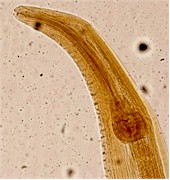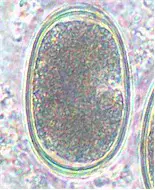Heterakis is a genus of parasitic roundworms belonging to the pinworms that infects chickens, turkeys, ducks, geese, grouse, quails, pheasants, guinea fowls and other domestic and wild birds. They are also called cecal worms.
belonging to the pinworms that infects chickens, turkeys, ducks, geese, grouse, quails, pheasants, guinea fowls and other domestic and wild birds. They are also called cecal worms.
They occur worldwide and are very common in chicken: up to 90% of a population can be infected. It is more abundant in traditional farming with outdoor run than in industrial production facilities.
These worms do not affect dogs, cats, cattle sheep, goats, horses or swine.
The most relevant species for domestic birds are:
- Heterakis gallinarum infects mainly chicken, but also turkey, geese, guinea fowls, etc.
- Heterakis dispar infects mainly ducks and geese.
- Heterakis isolonche infects mainly pheasants and other wild birds.
The disease caused by Heterakis worms is called heterakiasis or heterakiosis.
Are birds infected with Heterakis worms contagious for humans?
- NO: The reason is that these worms are not human parasites.
You can find additional information in this site on the general biology of parasitic worms and/or roundworms.
Final location of Heterakis worms
Predilection site of adult Heterakis worms is the cecum. Occasionally they are found also in the gut.
Anatomy of Heterakis worms

Adult Heterakis worms are rather small roundworms, not longer than 15 mm, very thin and of a whitish color. Females are longer than males.
As in other roundworms, the body of these worms is covered with a cuticle, which is flexible but rather tough. The worms have a tubular digestive system with two openings. They also have a nervous system but no excretory organs and no circulatory system, i.e. neither a heart nor blood vessels.
Males have tail flaps (alae) and a copulatory bursa with two unequally long spicules for attaching to the female during copulation.
Heterakis eggs are ovoid, about 45x75 micrometers, with a thick and smooth shell, and contain a single cell that fills also the egg poles. They are very similar to those of Ascaridia galli, but smaller: Heterakis eggs are not longer than 77 micrometers.
Life cycle of Heterakis worms
Heterakis worms have direct life cycle. Adult female worms in the small intestine pass eggs with the feces (about 100 per day per female!). Once in the environment infective L2-larvae develop inside the eggs in 1 to 10 weeks, strongly depending on temperature. These eggs can remain infective in the birds' litter and the environment for one year and longer and may survive slight frost. Earthworms and houseflies can ingest infective eggs and act as mechanical vectors (paratenic hosts).
Birds become infected after eating infective worm eggs either directly with contaminated food or water, or indirectly when eating earthworms or flies. Ingested eggs release the larvae in the gut's lumen in a few hours after ingestion. Hatched larvae reach the cecum one day later. Some larvae may penetrate the lining of the cecum, but it seems that most do not and complete development to adult worms in the lumen of the cecum after several molts.
The prepatent period (time between infection and first eggs shed) is 3 to 4 weeks, depending on the worm species and the host.
Harm caused by Heterakis worms, symptoms and diagnosis

Heterakis infections are not very pathogenic for poultry. Heavy infections can cause inflammation and thickening of the cecum, appearance of nodules and numerous small bleedings in the cecal wall, especially in turkey. Egg production in layers can be significantly reduced.
However, the major problem is that these worms are vectors of Histomonas meleagridis, a protozoan parasite that affects chicken, turkey, quails, pheasants and many other birds and is the causative agent of the blackhead disease, also called histomoniasis or infectious enterohepatitis.
These protozoans remain viable in the eggs. They are particularly harmful and often fatal for turkeys. They can destroy large portions of the gut's wall and liver tissues.
Diagnosis is based on detection of typical eggs in the feces and/or on identification of the worms in the cecum after necropsy.
Prevention and control of Heterakis infections
To prevent or at least reduce Heterakis infections it is recommended to keep the birds' bedding as dry as possible and to frequently change it, because development of the worm's eggs needs humidity. Strict hygiene of feeders and drinkers are a must to avoid or reduce their contamination with eggs. Pasture rotation is also recommended. All these measures are especially important for young birds, particularly for turkeys, which are likely to suffer more from Heterakis infections. They are highly recommended in flocks with a past history of histomoniasis.
Numerous classic broad spectrum anthelmintics are effective against Heterakis worms, e.g. several benzimidazoles (albendazole, fenbendazole, flubendazole, mebendazole, oxfendazole, etc.), levamisole, as well as macrocyclic lactones (e.g. ivermectin). Some compounds with a narrower spectrum are also effective against these worms, e.g. piperazine derivatives and pyrantel.
For use on poultry these active ingredients are usually available as additives for feed or drinking water, seldom as injectables or tablets (mainly for single animal treatment, typical for fighting roosters).
Most such wormers (e.g. benzimidazoles, levamisole, piperazine derivatives and pyrantel) kill the worms shortly after treatment and are quickly metabolized and/or excreted within a few hours or days. This means that they have a short residual effect, or no residual effect at all. As a consequence treated animals are cured from worms but do not remain protected against new infections. To ensure that they remain worm-free the animals have to be dewormed periodically, depending on the local epidemiological, ecological and climatic conditions.
So far no vaccine is available against Heterakis worms. To learn more about vaccines against parasites of livestock and pets click here.
Biological control of Heterakis worms (i.e. using its natural enemies) is so far not feasible.
You may be interested in an article in this site on medicinal plants against external and internal parasites.
Resistance of Heterakis worms to anthelmintics
There are a no reports on confirmed resistance of Heterakis worms to anthelmintics.
This means that if an anthelmintic fails to achieve the expected efficacy against Heterakis worms it is most likely that either the product was unsuited for the control of these worms, or it was used incorrectly.
|
Ask your veterinary doctor! If available, follow more specific national or regional recommendations for Heterakis control. |